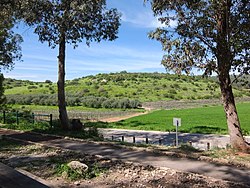
Back Judea Afrikaans Judäa ALS يهودا (منطقة) Arabic Xudea AST İudeya Azerbaijani یهودیه AZB Іўдзея Byelorussian Юдэя BE-X-OLD Юдея Bulgarian যিহূদিয়া Bengali/Bangla
Judea
יְהוּדָה | |
|---|---|
 | |
 | |
| Coordinates: 31°40′N 35°00′E / 31.667°N 35.000°E | |
| Location | Southern Levant |
| Part of | |
| Native name | יְהוּדָה |
| Highest elevation | 1,020 m or 3,350 ft |
Judea or Judaea (/dʒuːˈdiːə, dʒuːˈdeɪə/;[1] Hebrew: יהודה, Modern: Yəhūda, Tiberian: Yehūḏā; Greek: Ἰουδαία, Ioudaía; Latin: Iudaea) is a mountainous region of the Levant. Traditionally dominated by the city of Jerusalem, it is now part of Palestine and Israel. The name's usage is historic, having been used in antiquity and still into the present day; it originates from Yehudah, a Hebrew name. Yehudah was a son of Jacob, who was later given the name "Israel" and whose sons collectively headed the Twelve Tribes of Israel. Yehudah's progeny among the Israelites formed the Tribe of Judah, with whom the Kingdom of Judah is associated. Related nomenclature continued to be used under the rule of the Babylonians (the Yehud province), the Persians (the Yehud province), the Greeks (the Hasmonean Kingdom), and the Romans (the Herodian Kingdom and the Judaea province).[2] Under the Hasmoneans, the Herodians, and the Romans, the term was applied to an area larger than Judea of earlier periods. In 132 CE, the Roman province of Judaea was merged with Galilee to form the enlarged province of Syria Palaestina.[3][4][5]
The term Judea was used by English speakers for the hilly internal part of Mandatory Palestine until the Jordanian rule of the area in 1948.[6][7] Most of the region of Judea was incorporated into what the Jordanians called ad-difa'a al-gharbiya (translated into English as the "West Bank"),[8] though "Yehuda" is the Hebrew term used for the area in modern Israel since the region was captured and occupied by Israel in 1967.[9] The Israeli government in the 20th century used the term Judea as part of the Israeli administrative district name "Judea and Samaria Area" for the territory that is generally referred to as the West Bank.[10]
- ^ "Definition of Judaea in English". Lexico Dictionaries. Archived from the original on 20 July 2021. Retrieved 20 July 2021.
- ^ Crotty, Robert Brian (2017). The Christian Survivor: How Roman Christianity Defeated Its Early Competitors. Springer. p. 25 f.n. 4. ISBN 9789811032141. Retrieved 28 September 2020.
The Babylonians translated the Hebrew name [Judah] into Aramaic as Yehud Medinata ('the province of Judah') or simply 'Yehud' and made it a new Babylonian province. This was inherited by the Persians. Under the Greeks, Yehud was translated as Judaea and this was taken over by the Romans. After the Jewish rebellion of 135 CE, the Romans renamed the area Syria Palaestina or simply Palestine. The area described by these land titles differed to some extent in the different periods.
- ^ Clouser, Gordon (2011). Jesus, Joshua, Yeshua of Nazareth Revised and Expanded. iUniverse. ISBN 978-1-4620-6121-1.
- ^ Spolsky, Bernard (2014). The Languages of the Jews: A Sociolinguistic History. Cambridge University Press. ISBN 978-1-107-05544-5.
- ^ Brand, Chad; Mitchell, Eric; Staff, Holman Reference Editorial (2015). Holman Illustrated Bible Dictionary. B&H Publishing Group. ISBN 978-0-8054-9935-3.
- ^ Cite error: The named reference
:7was invoked but never defined (see the help page). - ^ Cite error: The named reference
:8was invoked but never defined (see the help page). - ^ Cite error: The named reference
Philologoswas invoked but never defined (see the help page). - ^ Cite error: The named reference
:9was invoked but never defined (see the help page). - ^ Neil Caplan (19 September 2011). The Israel-Palestine Conflict: Contested Histories. John Wiley & Sons. p. 8. ISBN 978-1405175395.